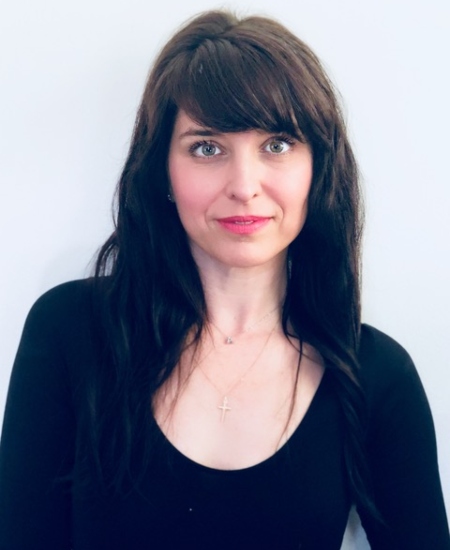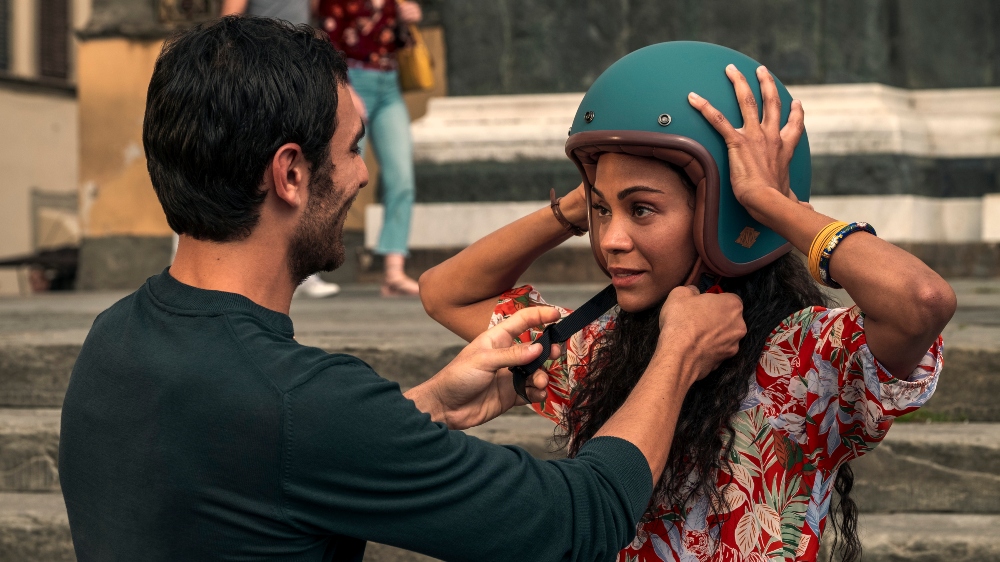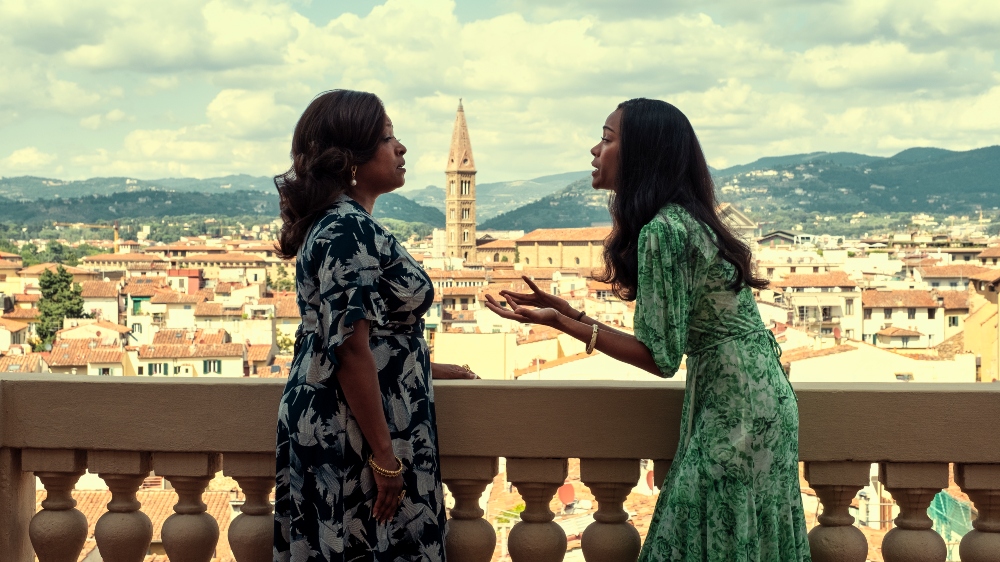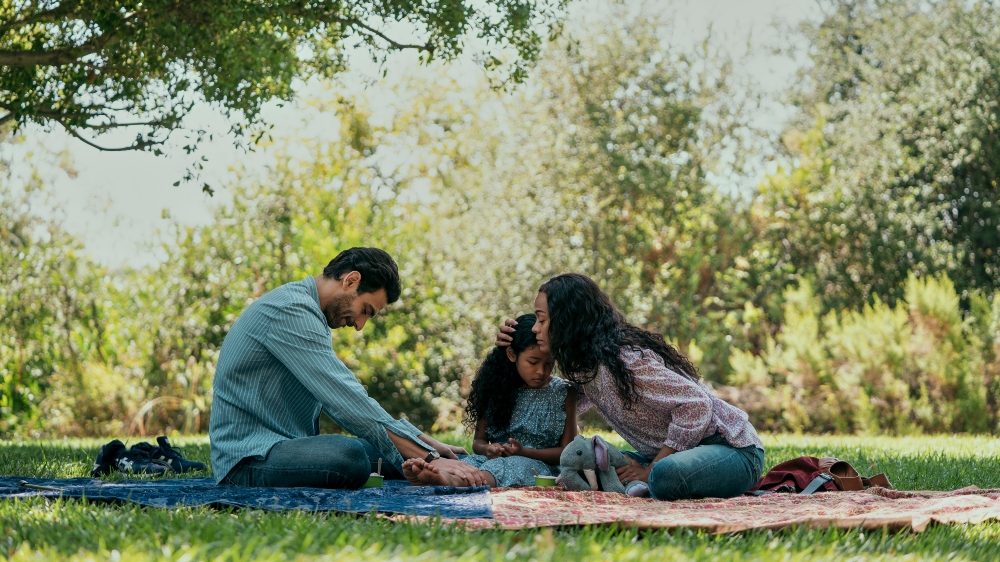In Netflix’s adaptation of Tembi Locke’s book From Scratch, Amy Wheeler (Zoe Saldaña) finds unexpected romance in Italy. One of the key below-the-line elements of this engaging international limited series is its costume design, as the characters’ clothing reflects their national origins and the times they live in, which transform over the course of the show’s eight episodes.
Below the Line recently spoke to veteran Costume Designer Amanda Riley about her work on the series, and she discussed her efforts in striving for authenticity, and how shopping in Italy for the right outfits and material enhanced the show overall. She was also excited to dive into Amy’s life and follow her story throughout Europe, which harkened back to the character’s own Texas roots.
Riley also talked about her other gigs, including her time on the short-lived but still memorable CBS series Jericho and one of TV’s more complex series — Westworld, which appealed to her precisely because she struggled to understand it.

Below the Line: What appealed to you about From Scratch?
Amanda Riley: First of all, I love love stories. I think, nowadays, for me to do any sort of content that has to do with love and hope and travel, it always really appeals to me. From Scratch was a very special story, since it’s the story of a woman’s life. What appealed to me was to be able to tell a beautiful story about someone’s life throughout all of the joy and all of the hardship.
I live now in Paris, and so, from a costuming perspective, to be able to go from the early 2000s into the next decade, starting in Florence, Italy, was great. It’s one thing to work in period, but it’s another thing to actually be in the place where the story is taking place and to have to roll back the hands of time. We were in Sicily for the end of it, and playing with those periods in the real places was very rewarding.
BTL: Does that present a challenge, trying to roll back time and find things that aren’t as contemporary but are recent enough that they could pass for that era?
Riley: What I have understood the most, and why I enjoy this project so much, is that there’s a classic element to fashion, not only in France but also in Italy. Even though we were doing early 2000s, there are, of course, certain elements of it that are period. You can draw elements from the ’90s the ’80s, and, of course, things that are just completely classic, like men’s and women’s wear of the regular Italian population, where the cuts are just very clean and I feel like it’s extremely timeless.
So, for me, as a designer, what I tried to focus on was what felt like the most harmless thing that you could use without anything looking super trendy. When we look back at the early 2000s, it’s very specific, especially if you look at the difference between what people were potentially wearing in Europe, where you can see elements of it that are very trendy [at] that time, and what people were wearing in Los Angeles in the early 2000s. We can all remember Justin Timberlake and Britney Spears. I think Justin Timberlake had a full tuxedo that was completely denim, and then I always think of Friends because there was so much silk charmeuse that was chartreuse green, and it’s just very specific, the super low rise, bootcut jeans, and a lot of torn elements.
BTL: In From Scratch, Amy is an American traveling the world and her wardrobe develops as she visits different places.
Riley: Yes, and also, too, one thing I like to remind people here in France is that Europe is one thing, [but] each country kind of has their own energy, [and] so does the United States. She came from Texas. The fashion elements of Texas are very different from what people are wearing in L.A. and what people are wearing in New York. So there is definitely a definition of what you can see that does evolve, being from different places.

BTL: Aside from Amy, were there any other characters you were particularly excited to be able to costume?
Riley: Yes. Looking back on the journey of the whole project, if you understand Italy as a culture, there’s Northern Italy and Southern Italy and there are all these [different] elements. But then you have Sicily. Sicily is kind of its own dimension, in a sense, where a lot of it is stuck in a time capsule. These women, especially the widows [who] we were dressing, what they have is very specific. In fact, one of the great adventures that I had in this job was that I was able to design clothes from scratch for our lead character, the mother character, which was such a great opportunity because I couldn’t find anything that made the most sense, that didn’t feel too incredibly, like, of the Epoque of the ’40s or ’50s, [and] that still felt contemporary, but didn’t feel too modern. There were some pieces that were just modern and very simple, that you could still see women wear today, [just as] you could see them wear [them] 10 years ago. There were some that you could look at and it was like pulling elements from all different time periods. That was such an opportunity, and the other thing that I got to do is that I had the opportunity to travel with the team that I had assembled there.
We were based in Florence for the first part of it, but I was able to travel around to Rome and Naples, and Bologna. To be able to travel around and go to all these different vintage warehouses and be able to pull things that were Italian was beneficial. A lot of things came from L.A. [and] a lot of costumes had already been established, especially for the main characters, but to be able to go to these flea markets, especially in Sicily, [and buy] some of these women’s house dresses and some of the aprons they’ve been wearing for the last 20 or 30 years. They never really changed. So I could still go to a market where women are buying sponges and house slippers, and it’s kind of still the same thing. That was such a great opportunity because it was all right there. Rather than trying to source it in the States, I had the opportunity to buy a lot of it there, which was really, really helpful because it is very different. In the United States, we’re so used to having such a volume of things, but it’s not necessarily the right thing and it’s not necessarily something that is of the right period. There, it’s fewer things, but the things are either of a better quality or [they’re] the right piece.
BTL: Looking through your resume, a lot of the shows that I see on there are in the sci-fi and fantasy genre, but they’re mostly contemporary and set in the United States, like Supergirl, Stargirl, and Agents of S.H.I.E.L.D. On those projects, is most of your time spent on the uniforms and the costumes, or is there just as much effort put into the normal, everyday clothing that everyone else is wearing?
Riley: It’s so interesting because I love period so much, and as a viewer of content, I’m not a person who necessarily chooses futuristic or sci-fi. But as a costume designer, what makes those kinds of projects so incredible is that you are doing so much research and development to get to the costumes state. By the time you arrive [at] a specific costume, you’ve done all the research and development. Working on a show like Supergirl, her costume [was] tweaked, but it was really developed when I came. So I was able to work on Alex’s costume and develop that from scratch, but so much time and energy go into creating the superhero costumes. Once those are set throughout the series, because you always have different adversaries coming in, there’s a certain level of volume. I absolutely loved that job on Supergirl because there was a comedic [element] and a fashion element to it. We had actors in suits and very constructed outfits because they worked in an office, and so that did take time to be able to source and fit and make sure that for each episode, we had costumes for that. It’s kind of equal, in a sense. You’re working on both things simultaneously, and they both require attention and work.

BTL: In another sci-fi show, Westworld, you’re helping to recreate the Old West. But then, a lot of the hosts in the later seasons have this really sleek, very well-dressed, purposeful look to them. That show is an interesting contradiction in itself.
Riley: I started in this industry as a costume designer very early on. I had gotten a lot of opportunities to do smaller stuff, recreation stuff, which as a designer, is such an amazing opportunity to be able to play in all these different fields. Of course, there’s always pressure, but it’s not the same kind of pressure because you’re recreating it and you have some liberties. I had always wanted to have the opportunity of starting from the bottom [and] working on set. As a designer, being able to start on the ground in front of the camera where you’re setting all the rooms and you really see what the work is like as a set person is very important. I got to work on CBS’ Jericho, and what was so incredible about that show is that there was so much aging and so many stunts and all that. To be able to draw [on] a lot of those pieces later on [for] some of the other projects that I did was very helpful.
When it came to Westworld. I always wanted to work on that show because I never understood it. I was so mesmerized by it that I actually reached out to the costume designer [who[ was doing it at the time. In the industry, people ask, “how do you even get your jobs? Do you have an agent or is a lot of it word of mouth?” You just never know, right? It’s an interesting wheel of being able to find a job. When it came to Westworld, I had this dream [and] I really wanted to work on it, so I sent my resume to the Costume Designer, Shay Cunliffe, who is one of the most incredible human beings and talents on the planet. She decided to bring me on because it was such a big show. We did Episode 3, and that episode was nominated for an Emmy, and that’s where things started to get really futuristic. The original trailer was a Pink Floyd song, and he’s walking across the bridge, and it was just so cool. All the music and all of the artistry.
But what made Westworld, from a creative standpoint, such an incredible job to work on is that you know that it is going to be a long day. You know that there’s going to be a lot of things thrown in your direction, and we’re almost like soldiers showing up each day for work, because every single person that’s there, they’re not complaining, they know it’s going to be a long day, and we are absolutely ready to catch anything that comes — because there are so many stunts, because there are so many people cast last-minute, [and] because there are so many stars and this incredible talent. Having some of these people walk into the fitting room and seeing some of these people, they kind of have that thing.
For me, that was the most incredible experience, from the perspective of just knowing, whatever it is at the end of the day, the following day, the work will get done. We will be able to create what[ever] it is that needs to be seen in front of the camera, and everybody’s here to make sure it happens. Because the machine is [constantly] evolving, it really is the creative process where, a lot of times, you get information ahead of time, and sometimes you don’t get it that much ahead of time. So that day, or within a couple [of] days, you’re creating an entire look for somebody, obviously with the help of the designer, Shay, and then all of us behind her assisting in that vision, making sure that it came true. [It was] such an incredible process because of how fluid it was, and just such a moving engine.

BTL: The other show that I wanted to ask you about may be, out of everything you’ve done, the closest to From Scratch, but tonally a little different. ABC’s Don’t Trust the B—- in Apartment 23, which was before Krysten Ritter was Marvel-famous, and she was also a very fashion-centric character.
Riley: Yes. My role on that job, I didn’t really do a lot of the design aspects of it, but I think, when you’re working with a team of people, the designers [who] I worked with continue to be amazing friends of mine. Because Krysten was so involved in that show, it was amazing to be able to push a lot of the fashion elements. When I look at a show like Don’t Trust the B—- in Apartment 23, I feel like it had the opportunity, comedically, to be able to push a lot of the fashion elements.
Zoe Saldaña is so incredibly elegant in everything she wears, she can put anything on, and with From Scratch, the most important thing about the job was that I just wanted every character to feel incredibly individual, so each character had their own notes and each character had their own feelings, so that when you saw each character, it’s like, “oh, Zora would totally wear that,” or, “oh, that’s, like, a complete Lynn piece.”
BTL: Is there any project that I didn’t ask you about that stands out for you from your career?
Riley: I did a show not that recently called Sweet/Vicious. It was an MTV show, and unfortunately, we only got one season out of it. But what was so cool about that show that I really loved was that the show was about women taking on the role of chasing after these men [who] were not kind to two women. It was a sorority show and it was very contemporary, but what I loved about it is that the two young girls I was able to dress beat up these men [who] were raping and roofying girls at parties. They were stars at college, and so these girls decided to become vigilantes and chase after these guys, and take matters into their own hands and beat them up. I liked being able to portray these young, beautiful women as total badasses. That was a really beautiful show that I did that I’m definitely very proud of.
From Scratch is now streaming on Netflix.
https://www.youtube.com/watch?v=vBHKSQ4MrJE





